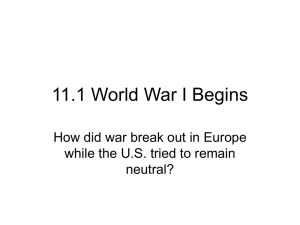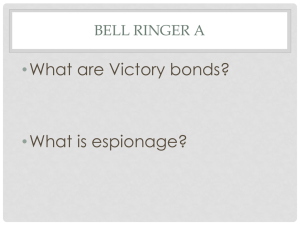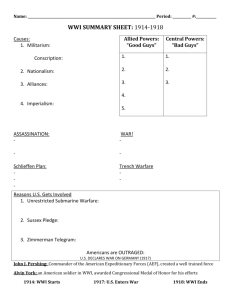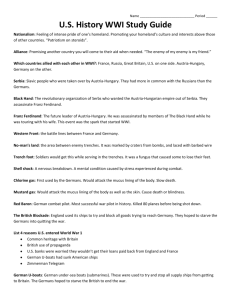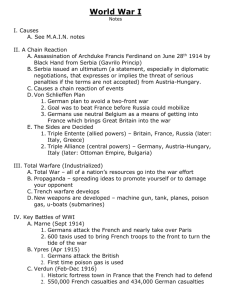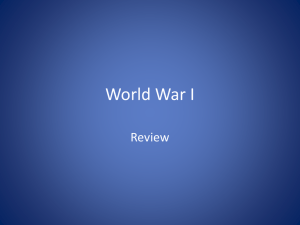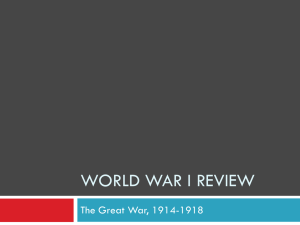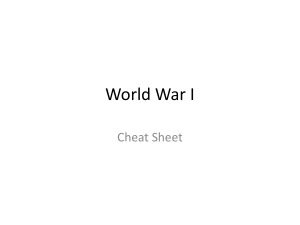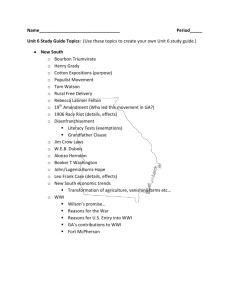WWI Study Guide
advertisement
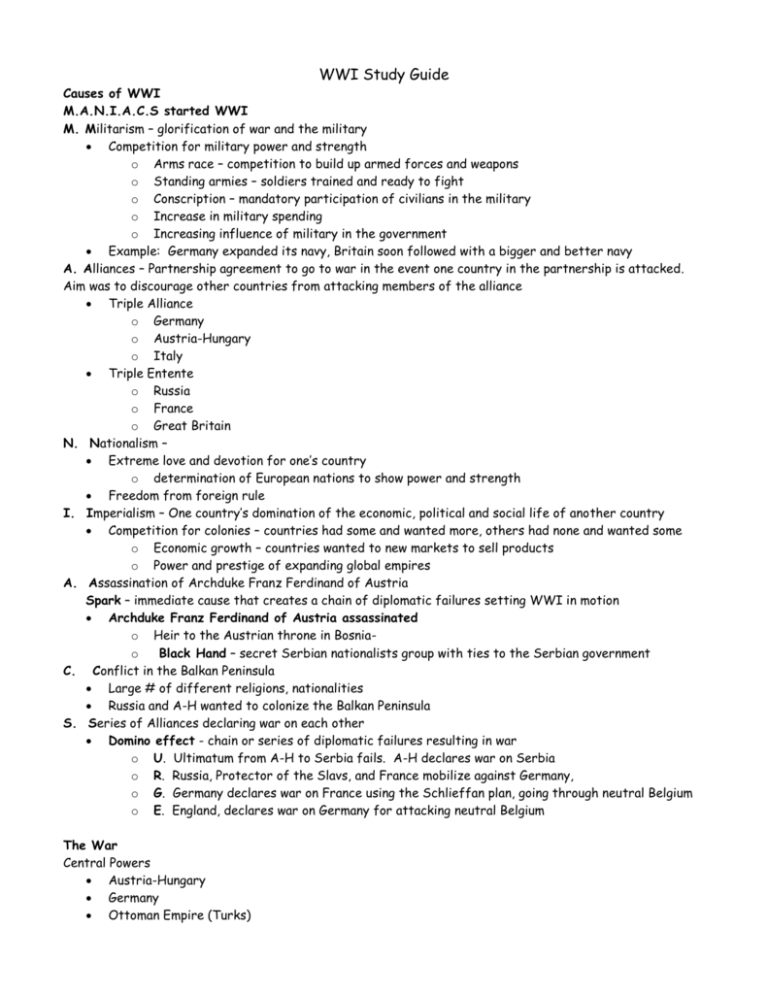
WWI Study Guide Causes of WWI M.A.N.I.A.C.S started WWI M. Militarism – glorification of war and the military Competition for military power and strength o Arms race – competition to build up armed forces and weapons o Standing armies – soldiers trained and ready to fight o Conscription – mandatory participation of civilians in the military o Increase in military spending o Increasing influence of military in the government Example: Germany expanded its navy, Britain soon followed with a bigger and better navy A. Alliances – Partnership agreement to go to war in the event one country in the partnership is attacked. Aim was to discourage other countries from attacking members of the alliance Triple Alliance o Germany o Austria-Hungary o Italy Triple Entente o Russia o France o Great Britain N. Nationalism – Extreme love and devotion for one’s country o determination of European nations to show power and strength Freedom from foreign rule I. Imperialism – One country’s domination of the economic, political and social life of another country Competition for colonies – countries had some and wanted more, others had none and wanted some o Economic growth – countries wanted to new markets to sell products o Power and prestige of expanding global empires A. Assassination of Archduke Franz Ferdinand of Austria Spark – immediate cause that creates a chain of diplomatic failures setting WWI in motion Archduke Franz Ferdinand of Austria assassinated o Heir to the Austrian throne in Bosniao Black Hand – secret Serbian nationalists group with ties to the Serbian government C. Conflict in the Balkan Peninsula Large # of different religions, nationalities Russia and A-H wanted to colonize the Balkan Peninsula S. Series of Alliances declaring war on each other Domino effect - chain or series of diplomatic failures resulting in war o U. Ultimatum from A-H to Serbia fails. A-H declares war on Serbia o R. Russia, Protector of the Slavs, and France mobilize against Germany, o G. Germany declares war on France using the Schlieffan plan, going through neutral Belgium o E. England, declares war on Germany for attacking neutral Belgium The War Central Powers Austria-Hungary Germany Ottoman Empire (Turks) Allied Powers Great Britain Russia France Belgium US joins (April 2, 1917) Key Leaders during WWI William II - Germany o Emperor of Germany in World War I. Czar Nicholas II – Russia o last czar of Russia, Absolute Monarch Woodrow Wilson – US o President of the United States o At the outbreak of the WWI, he tried to maintain American neutrality as long as possible Schlieffen Plan – Germany had to fight a war on two fronts (east with France/Great Britain and west with Russia) Western Front: 1. Stalemate – a state of deadlock where neither side gains an advantage 2. Trench warfare - a type of armed combat in which the two opposing sides fight from trenches that face each other to protect soldiers from the onslaught of machine gun fire and other weaponry A series of trenches stretched from the North Sea to Switzerland No man’s land – the desolate area that separated the two sides of trenches Barbed wire and land mines protected the area in front of each trench Attacks – soldiers charged “over the top” of their own trenches, through no man’s land to enemy trenches, facing heavily artillery, machine guns, barbed wire, and land-mines Soldiers lived in the trenches for several weeks o Disease, cold, mud, rats, rain New Weapons Machine guns – allowed one man to kill hundreds of men in seconds Poisonous gas – German army was first ever to used o Chlorine gas – caused blindness, choking, vomiting, torn lungs, and death o Mustard gas – most deadly, caused skin blisters, sore eyes, vomiting, internal and external bleeding, a long slow death Tanks – allowed for movement across rugged terrain, eventually designed to cross trenches Airplanes – first used for reconnaissance work (spying), later in war to deliver bombs and fight enemy aircraft in they air Submarines – German u-boats destroyed warships, supply ships, and commercial and passenger ships U.S. Entry into the War Reasons did not enter in 1914 Policy of neutrality – policy of not choosing sides U.S. late entry – believed war was a European conflict and had nothing to do with the US Economic Reasons – keep trade open with both sides Reasons U.S. Enters – April 2, 1917 1. Lusitania – British passenger ship torpedoed by German u-boats; 1,200 die including 128 Americans 2. Zimmerman note – message from Arthur Zimmerman (German Foreign Minister) to his ambassador in Mexico. Info. Intended for Mexican President: Germany to reinstate unrestricted submarine warfare Germany wanted alliance with Mexico Mexico promised money 3. German U-boats continue to sink American merchant ships Russian Revolution Russian Revolution: Poor leadership caused the Bolshevik R.E.V.O.L.T. in 1917 R. Rasputin’s influence over the Czar E. Every landless peasant demanded land V. Violence broke out over bread shortages and military defeats O. Overthrow of provisional government was led by the Bolsheviks L. Lenin promises “Peace, Land, Bread” T. Czar’s Incompetence Fall of the Czar Food and Fuel Shortages Mounting defeats in WWI 1917 Czar Nicholas Abdicates (steps down) Provisional Government 1. Temporary Central Government 2. Big Mistake: Didn’t withdraw from the war Bolshevik Revolution – Nov. 1917 Leader – Vladimir Lenin Slogan – “Peace (end war), Land (give more land to the peasants), Bread (food)” Coup d’état – sudden overthrow of the government by people from with the country Socialist state – No private property, economic equality for all citizens (distribution of land to peasants, worker control of factories) End of war Austria-Hungary quits (Oct 1918) Nov. 11 – Armistice day – Germans agree to end fighting Effects of WWI o 9 Million soldiers dead o 21 Million soldiers wounded o 13 Million civilians were dead of disease or starvation WWI different from other wars: o Number of casualties o Use of new technologies o Scope of war – number of countries involved Colonies participated in hopes of gaining their independence o Asian and African colonies expected citizenship or independence Arabs wanting freedom from Ottoman Turks helped the British Amount of destruction Woodrow Wilson’s (US President) 14 points – peace plan o Freedom of the seas and trade o Arms limitations o End to secret alliances o Self-rule for all nations o No punishments to Germany o League of Nations – an organization of world nations to settle future problems peacefully Paris Peace Conference – delegates from 27 nations signed the Treaty of Versailles o “Big Four” - (France), (Britain), (Italy), Woodrow Wilson, (US) o Central Powers not invited o Most Important – Treaty of Versailles with Germany Treaty of Versailles – the treaty was a R.A.W. deal for Germany R. Reparations were forced on Germany o German war reparations – $33 B A. Allies Punish Germany - took German land/limit German military o German army reduced, o German weapons - can’t manufacture or buy weapons, no airforce o German to return Alsace-Lorraine to France o France gets control of Saar Basin (rich in coal deposits) o Occupation of the Rhineland o Germany stripped of Colonies W. War Guilt was forced on Germany o Germany must sign “war blame” clause New nations established o Finland, Estonia, Latvia, Lithuania, Czechoslovakia, Yugoslavia, Poland Yugoslavia created a united Slavic country on the Balkan Peninsula
